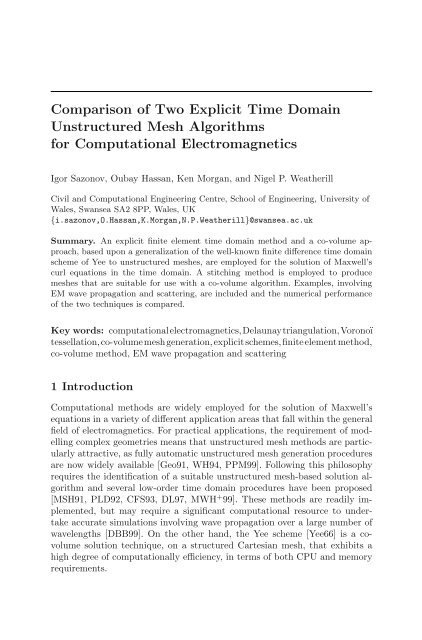Partial Differential Equations - Modelling and ... - ResearchGate
Partial Differential Equations - Modelling and ... - ResearchGate
Partial Differential Equations - Modelling and ... - ResearchGate
Create successful ePaper yourself
Turn your PDF publications into a flip-book with our unique Google optimized e-Paper software.
Comparison of Two Explicit Time Domain<br />
Unstructured Mesh Algorithms<br />
for Computational Electromagnetics<br />
Igor Sazonov, Oubay Hassan, Ken Morgan, <strong>and</strong> Nigel P. Weatherill<br />
Civil <strong>and</strong> Computational Engineering Centre, School of Engineering, University of<br />
Wales, Swansea SA2 8PP, Wales, UK<br />
{i.sazonov,O.Hassan,K.Morgan,N.P.Weatherill}@swansea.ac.uk<br />
Summary. An explicit finite element time domain method <strong>and</strong> a co-volume approach,<br />
based upon a generalization of the well-known finite difference time domain<br />
scheme of Yee to unstructured meshes, are employed for the solution of Maxwell’s<br />
curl equations in the time domain. A stitching method is employed to produce<br />
meshes that are suitable for use with a co-volume algorithm. Examples, involving<br />
EM wave propagation <strong>and</strong> scattering, are included <strong>and</strong> the numerical performance<br />
of the two techniques is compared.<br />
Key words: computationalelectromagnetics,Delaunaytriangulation,Voronoï<br />
tessellation,co-volumemeshgeneration,explicitschemes,finiteelementmethod,<br />
co-volume method, EM wave propagation <strong>and</strong> scattering<br />
1 Introduction<br />
Computational methods are widely employed for the solution of Maxwell’s<br />
equations in a variety of different application areas that fall within the general<br />
field of electromagnetics. For practical applications, the requirement of modelling<br />
complex geometries means that unstructured mesh methods are particularly<br />
attractive, as fully automatic unstructured mesh generation procedures<br />
are now widely available [Geo91, WH94, PPM99]. Following this philosophy<br />
requires the identification of a suitable unstructured mesh-based solution algorithm<br />
<strong>and</strong> several low-order time domain procedures have been proposed<br />
[MSH91, PLD92, CFS93, DL97, MWH + 99]. These methods are readily implemented,<br />
but may require a significant computational resource to undertake<br />
accurate simulations involving wave propagation over a large number of<br />
wavelengths [DBB99]. On the other h<strong>and</strong>, the Yee scheme [Yee66] is a covolume<br />
solution technique, on a structured Cartesian mesh, that exhibits a<br />
high degree of computationally efficiency, in terms of both CPU <strong>and</strong> memory<br />
requirements.
















